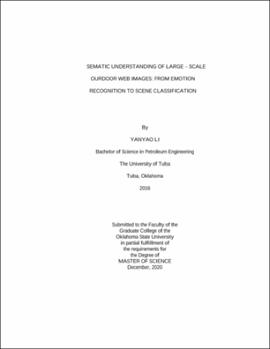| dc.contributor.advisor | Fan, Guoliang | |
| dc.contributor.author | Li, Yanyao | |
| dc.date.accessioned | 2021-05-25T20:42:21Z | |
| dc.date.available | 2021-05-25T20:42:21Z | |
| dc.date.issued | 2020-12 | |
| dc.identifier.uri | https://hdl.handle.net/11244/329962 | |
| dc.description.abstract | Facial expression recognition and scene-based image clustering are very popular topics in the fields of human-computer interaction and computer vision. Their relationship has been rarely investigated but is a very attractive topic that has many potential applications, such as landscape design, instructions for vacation choices, or plant layout design in the public space. In this research, we use the existing deep learning algorithms to study two issues, i.e., facial expression recognition and scene-based image clustering for large scale outdoor web images. This research paves a path for a future attempt that explores their relationship in real-world images. First, we concentrate on emotion recognition and investigate the performance of the well-known algorithms including Visual Geometry Group Network (VGG network) and Residual Net (ResNet) on the emotions in images captured from a public park. Then we introduce some approaches to address the challenges of the occluded or children's faces. Our proposed pre-processing schemes not only allow the algorithm to detect more faces but also to increase the rate of recognition accuracy under the complex environment. We also investigate the visual analysis of landscape by introducing a set of scene labels for a large set of natural scene images collected from an online source. Then the weakly supervised method - Curriculum Net is applied for scene labeling of our dataset. In Curriculum Net, the training dataset is split into two parts, clean (easy) and noisy (hard) datasets by using a Density Peak Clustering algorithm, from which Curriculum Net is trained from easy to hard data. Particularly, we adopt a more effective density clustering method, Hierarchical Density-Based Spatial Clustering of Applications with Noise (HDBSCAN), to improve the clean-noisy separation of training images that leads to the improved scene labeling performance. By summarizing the work in emotion recognition and scene-based image clustering, we prepare the future research to reveal the relationship between the two aspects in real-world scenarios. | |
| dc.format | application/pdf | |
| dc.language | en_US | |
| dc.rights | Copyright is held by the author who has granted the Oklahoma State University Library the non-exclusive right to share this material in its institutional repository. Contact Digital Library Services at lib-dls@okstate.edu or 405-744-9161 for the permission policy on the use, reproduction or distribution of this material. | |
| dc.title | Sematic understanding of large-scale outdoor web images: From emotion recognition to scene classification | |
| dc.contributor.committeeMember | Zhang, Bo | |
| dc.contributor.committeeMember | Yen, Gary G. | |
| osu.filename | Li_okstate_0664M_17038.pdf | |
| osu.accesstype | Open Access | |
| dc.type.genre | Thesis | |
| dc.type.material | Text | |
| dc.subject.keywords | deep learning | |
| dc.subject.keywords | emotion recognition | |
| dc.subject.keywords | image clustering | |
| dc.subject.keywords | landscape design | |
| thesis.degree.discipline | Electrical Engineering | |
| thesis.degree.grantor | Oklahoma State University | |
